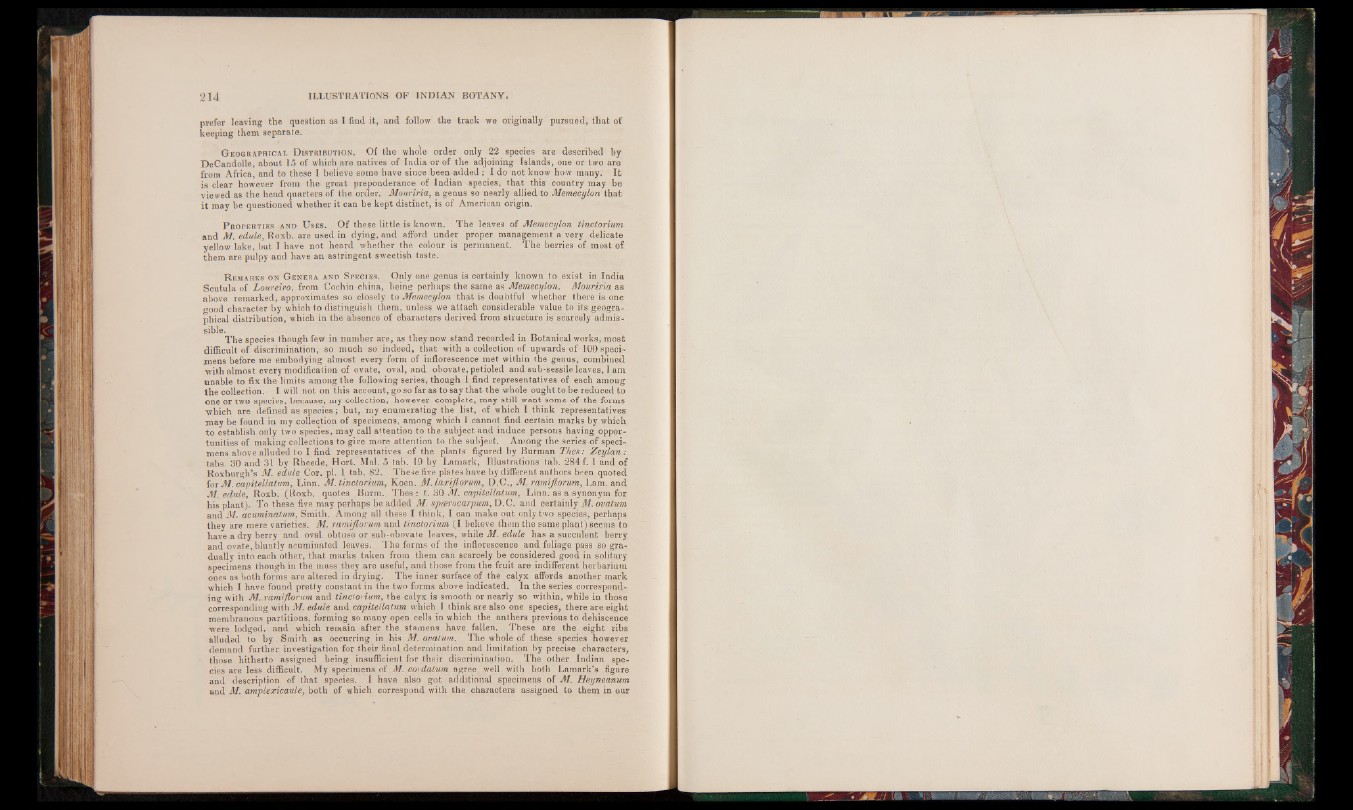
prefer leaving the question as I find it, and follow the track we originally pursued, that of
keeping them separate.
G e o g r a p h ic a l D i s t r ib u t io n . Of the whole order only 22 species are described by
DeCandolle, about 15 of which are natives of India or of the adjoining Islands, one or two are
from Africa, and to these I believe some have since been added : I do not know how many. It
is clear however from the great preponderance of Indian species, that this country may be
viewed as the head quarters of the order. Mouriria, a genus so nearly allied to Memecylon that
it may be questioned whether it can be kept distinct, is of American origin.
P r o p e r t ie s a n d U s e s . Of these little is known. The leaves of Memecylon tinctorium
and M. edule, Roxb. are used in dying, and afford under proper management a very delicate
yellow lake, but I have not heard whether the colour is permanent. The berries of most of
them are pulpy and have an astringent sweetish taste.
R em a r k s o n G e n e r a a n d S p e c i e s . Only one genus is certainly known to exist in India
Scutula of Loureiro, from Cochin-china, being perhaps the same as Memecylon. Mouriria as
above remarked, approximates so closely to Memecylon that is doubtful whether there is one
good character by which to distinguish them, unless we attach considerable value to its geographical
distribution, which in the absence of characters derived from structure is scarcely admissible.
The species though few in number are, as they now stand recorded in Botanical works, most
difficult of discrimination, so much so indeed, that with a collection of upwards of 100 specimens
before me embodying almost every form of inflorescence met within the genus, combined
■with almost every modification of ovate, oval, and obovate, petioled and sub-sessile leaves, I am
unable to fix the limits among the following series, though I find representatives of each among
the collection. I will not on this account, go so far as to say that the whole ought to be reduced to
one or two species, because, my collection, however complete, may still want some of the forms
which are defined as species; but, my enumerating the list, of which I think representatives
may be found in my collection of specimens, among which I cannot find certain marks by which
to establish only two species, may call attention to the subject and induce persons having opportunities
of making collections to give more attention to the subject. Among the series of specimens
above alluded to I find representatives of the plants figured by Burman Thes: Zeylan:
tabs. 30 and 31 by Rheede, Hort. Mai. 5 tab. 19 by Lamark, Illustrations tab. 284 f. 1 and of
Roxburgh’s M. edule Cor. pi. 1 tab. 82. These five plates have by different authors been quoted
for M. capitellatum, Linn. M. tinctorium, Koen. M.laxiflorum, D.C., M.ramiflorum, Lam. and
M. edule, Roxb. (Roxb. quotes Burm. Thes: t. 30 M. capitellatum, Linn, as a synonym for
his plant). To these five may perhaps be added M. spcerocarpum, D.C. and certainly M. ovatum
and M. acuminatum, Smith. Among all these I think, I can make out only two species, perhaps
they are mere varieties. M. ramiflorum and tinctorium (I believe them the same plant) seems to
have a dry berry and oval obtuse or sub-obovate leaves, while M. edule has a succulent berry
and ovate, bluntly acuminated leaves. The forms of the inflorescence and foliage pass so gradually
into each other, that marks taken from them can scarcely be considered good in solitary
specimens though in the mass they are useful, and those from the fruit are indifferent herbarium
ones as both forms are altered in drying. The inner surface of the calyx affords another mark
which I have found pretty constant in the two forms above indicated. In the series corresponding
with M. ramiflorum and tinctorium-, the calyx is smooth or nearly so within, while in those
corresponding with M. edule and capitellatum which I think are also one species, there are eight
membranous partitions, forming so many open cells in which the anthers previous to dehiscence
were lodged, and which remain after the stamens have fallen. These are the eight ribs
alluded to by Smith as occurring in his M. ovatum. The whole of these species however
demand further investigation for their final determination and limitation by precise characters,
those hitherto assigned being insufficient for their discrimination. The other Indian species
are less difficult. My specimens of M. cor datum agree well with both Lamark’s figure
and description of that species. I have also got additional specimens of M. Heyneanum
and M. amplexicaule, both of which correspond with the characters assigned to them in our